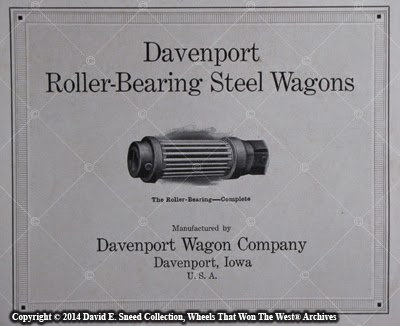I’ve shared several John Deere-relatedblogs over the past few months. Withconnections to Fort Smith, Moline, Mitchell, Old Hickory, Deere& Webber, Cyclone, and more wagon brands, the depth of Deere’s earlyinvolvement in wagon sales was truly amazing.
Soon after the turn of the 20th century,Deere determined to acquire its own wagon factories and began purchasing someof the best-known brands. One of the makesDeere secured in 1911 was the Davenport Wagon Company. Headquartered in Davenport, Iowa – just minutesacross the Mississippi River from Moline, Illinois – the brand was among themore unique and uncommon firms because of the design of their gears. These undercarriages were made entirely ofmetal and were promoted as being “built like a bridge.” Other features such as roller bearings, areinforced tongue and reach, and the use of linch pins instead of wheel nuts helpedthese workhorses stand out from other, potentially less reliable vehicles.
The excerpt below is from a 1912 catalog;possibly the first feature-length brochure about the brand as it was producedunder the new John Deere ownership.
“The DavenportWagon, with steel gearing, steel wheels, and roller-bearings, after the mostsevere and thorough tests, has easily proven far superior to the old style farmwagon… Because of the scarcity and inferior grade of wood the old style wagonis not, today, of as good quality as it was years ago… Particularly about thefarm do we notice advance and improvement in everything excepting thewagon. The implements are practicallyall steel. The steel wheel is used almostentirely on implements, the wooden wheel is rarely seen. The farmer appreciates the roller-bearing,its use is constantly increasing on farm equipment of all kinds…”
All of these statements supportingDavenport’s steel gears and wheels are especially interesting when oneconsiders that – at the same time – other John Deere-owned wagon brands were singing their separate, yet equally self-indulgent praises ofwood-wheeled superiority. Clearly, the company wasworking to optimize wagon sales in every corner of the market. When it came to the foundation of a Davenportgear, they were known for using steel I-beams, C channel steel, and angle irons– much like many quality trailer and equipment manufacturers still dotoday.
Benefits of the steel wheels and gearweren’t limited to strength and durability. Quietness and ease of maintenance were joined by the incorporation ofsteel roller bearing pins; promoted as helping to reduce the draft of the loadby as much as 30 to 50 per cent. Compared to traditional wooden wheels – which were more prevalent in theindustry – the company pointed out that these steel wheels were not affected bytemperature and moisture, so the dish always remained the same, allowing thewheel to run on the full face of the tire. The system was advertised as one which allowed the gear to maintaintruer tracking with plumb spokes and noticeably less wear to the wheel. Lubrication of the wheels was accomplishedthrough “oil cups” positioned on the hubs, allowing each wheel to be cared forwithout a need to jack up the wagon and wheels.
While Davenport Wagon Company’sbeginnings date to 1904, the idea for metal wagons originates muchearlier. Patents for an iron wagon gear inthe U.S. were issued as early as the time of America’s Civil War. Nonetheless, even with its advantages, it wasan idea that had trouble gaining traction. Deere’s vast distribution network and strong marketing budgets helped draweven more attention – and profits – to the design.
Among the Davenport brand offerings werestandard farm wagons, mountain wagons, cut-under wagons, lumber wagons, teaminggears, and even trail wagon equipment utilizing a horn and bumper. Boxes on the wagons were made of wood butwere touted as being heavily ironed and using additional hardwood cross sills, largerself-centering box rods, anti-spreader chains, and three sets of straddlercleats. Even though the Davenport wagonbrand ceased production nearly a century ago in 1917, the foundation for steelgears and wheels was laid and the combination would be used for decades more onthe farm – long after the company closed.


